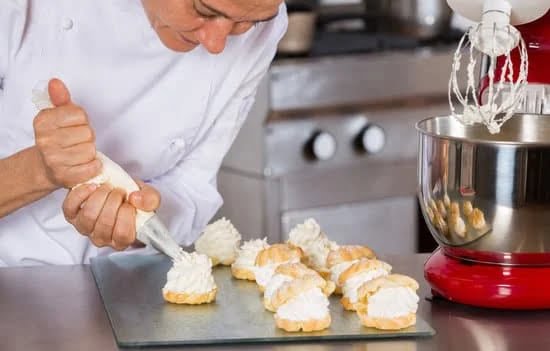Have you ever admired those beautiful buttercream rose cakes and wondered how to create one yourself? Look no further. In this article, we will explore the art of decorating a stunning buttercream rose cake. Whether you are an experienced baker or just starting out, this guide will provide you with step-by-step instructions and expert tips to help you create a truly exquisite masterpiece.
Before we dive into the techniques and intricacies of creating buttercream roses, it is important to understand the basics. Gathering the essential tools and ingredients is the first step towards success. We will discuss everything from piping bags and tips to the type of buttercream that works best for creating lifelike roses. By having all the necessary tools and ingredients on hand, you can ensure a smooth decorating process.
Once you have your tools and ingredients ready, it’s time to prepare the buttercream. Achieving the perfect consistency is crucial for creating beautifully piped roses. We will walk you through a step-by-step guide on how to achieve that ideal texture that allows for easy piping while still holding its shape. With our comprehensive instructions, you’ll be able to create a smooth and creamy buttercream that is perfect for your rose cake.
So get ready to unleash your creativity and learn how to decorate a buttercream rose cake like a pro. By following our detailed guide, you’ll soon be able to impress family and friends with your stunning creations. From gathering essential tools and ingredients to mastering various piping techniques, this article has got you covered. Let’s take your baking skills up a notch as we delve into the fascinating world of buttercream rose decoration.
Understanding the Basics
When it comes to decorating a stunning buttercream rose cake, understanding the basics and gathering the essential tools and ingredients is crucial. This section will guide you through the necessary items needed to create your masterpiece.
Tools
To begin with, make sure you have the following tools on hand before embarking on your buttercream rose cake journey:
- Piping bags: These are essential for piping the buttercream onto the cake. Make sure to have different sizes of piping bags for various techniques.
- Piping tips: Invest in a variety of petal tips such as 104 and 124 for creating different styles of roses. Leaf tips like 67 and 352 will be needed for adding leaves to your design.
- Turntable: A sturdy turntable can make all the difference in smoothly rotating your cake as you pipe on the roses.
- Spatulas: Have both angled and straight spatulas for spreading buttercream onto your cake layers, as well as smoothing out any imperfections.
- Offset spatula: This tool is useful for achieving clean edges and corners while frosting the cake.
Ingredients
In addition to having the right tools, it’s important to gather high-quality ingredients that will contribute to a delicious and beautiful buttercream rose cake. Here are some key ingredients you’ll need:
- Butter: Use unsalted butter at room temperature for a smooth and creamy texture in your buttercream.
- Powdered sugar: Also known as confectioner’s sugar, this ingredient provides sweetness and helps achieve a stable consistency in the frosting.
- Milk or cream: Adding small amounts of liquid can help adjust the consistency of your buttercream if it becomes too thick or stiff.
- Flavorings: Vanilla extract is commonly used to add flavor to buttercream, but you can explore other extracts like almond or lemon for unique taste accents.
- Food coloring: Depending on your design and personal preference, you may want to have gel or paste food coloring on hand to tint your buttercream into desired shades.
By ensuring that you have the necessary tools and ingredients at the beginning of your cake decorating journey, you’ll be setting yourself up for success. With a well-stocked toolkit and quality ingredients, you’ll be ready to dive into the art of buttercream rose decoration with confidence and excitement.
Preparing the Buttercream
Buttercream is the key component of a buttercream rose cake, and achieving the perfect consistency is crucial for successful decoration. Here, we will guide you through the step-by-step process of preparing buttercream with the right consistency to make your rose cake shine.
Gathering the Ingredients
To prepare the perfect buttercream, you will need a few essential ingredients. These include unsalted butter, icing sugar (also known as powdered sugar), milk or heavy cream, vanilla extract (or any desired flavoring), and a pinch of salt. Ensure that your butter is at room temperature for easier mixing and smoother results.
Mixing and Creaming
To start, beat the room temperature butter in a mixing bowl using an electric mixer on medium speed. This process is known as creaming, which incorporates air into the butter to create a light and fluffy texture. It usually takes about 2-3 minutes until the butter becomes pale in color.
Gradually Adding Icing Sugar
Once your butter has reached a creamy consistency, gradually add icing sugar to it. Begin by adding small amounts of icing sugar at a time while constantly mixing on low speed. This prevents lumps from forming and ensures that all ingredients are well incorporated.
Adjusting Consistency with Milk or Cream
As you add more icing sugar, your mixture may become thicker than desired. To adjust the consistency, gradually add milk or heavy cream while continuing to mix on low speed until you achieve the desired texture. Be cautious not to add too much liquid at once; otherwise, it may result in overly loose or runny buttercream.
By following these steps diligently, you will achieve a smooth and creamy buttercream with just the right consistency for piping beautiful roses onto your cake. Now that you have prepared your buttercream, it’s time to move on to the next step: building the base of your cake.
Building the Base
When it comes to creating a stunning buttercream rose cake, the foundation is crucial. Building a solid base takes careful planning and precision. In this section, we will explore some expert tips on baking and leveling the cake layers to ensure the perfect canvas for your buttercream masterpiece.
Gathering the Essential Tools and Ingredients
Before you begin, gather all the necessary tools and ingredients to make the baking process seamless. Here is a list of essential tools you will need:
- Mixing bowls: Have a few mixing bowls in different sizes handy to accommodate various stages of cake preparation.
- Measuring cups and spoons: Accurate measurements are crucial for achieving consistent results. Invest in a good set of measuring cups and spoons.
- Electric mixer: While mixing by hand is possible, an electric mixer will save you time and effort when creating smooth batter.
- Cake pans: Depending on your desired cake size, have two or three round or square cake pans ready.
- Offset spatula: An offset spatula will be useful for spreading batter evenly in pans as well as leveling cakes later on.
For ingredients, you will need:
- Flour: All-purpose flour works best for most cake recipes.
- Sugar: Granulated sugar will add sweetness to your cake.
- Butter or oil: Use either melted unsalted butter or vegetable oil to keep your cake moist.
- Eggs: Large eggs are typically used in cake recipes for structure and moisture.
- Leavening agents: Baking powder and baking soda help the cake rise during baking.
Step-by-step Guide to Achieving the Perfect Consistency
Once you have gathered all your tools and ingredients, it’s time to dive into preparing your cake layers with precision. Follow these steps for achieving perfect consistency:
- Preheat your oven according to the recipe instructions. This ensures that your oven reaches the desired temperature when you are ready to bake.
- Grease and flour your cake pans to prevent sticking. You can also use parchment paper for easier removal later on.
- In a mixing bowl, combine the dry ingredients, such as flour, sugar, baking powder, and baking soda. Whisk them together until well combined.
- In another mixing bowl, beat the butter or oil with an electric mixer until creamy and smooth. Gradually add in the eggs one at a time and continue beating until fully incorporated.
- Slowly add the dry ingredients to the wet mixture while alternating with any liquids specified in the recipe (such as milk or buttermilk). Mix until just combined and be careful not to overmix, as this can result in a dense cake.
- Divide the batter evenly among your prepared cake pans using an offset spatula or a spoon.
- Place the pans in the preheated oven and bake according to the recipe instructions. Check for doneness by inserting a toothpick into the center of each cake layer – it should come out clean or with just a few crumbs clinging to it.
- Once baked, remove the cakes from the oven and let them cool completely before moving onto leveling the layers.
By following these expert tips on baking and leveling your cake layers, you are setting yourself up for success when decorating your buttercream rose cake. A solid foundation ensures that your cake is not only visually appealing but also delicious from top to bottom.
Mastering the Art of Piping
Introduction to Piping Techniques
One of the key elements in decorating a stunning buttercream rose cake is mastering the art of piping. Piping refers to the technique of using a pastry bag and different tips to create various shapes and designs on a cake. When it comes to creating beautiful rose designs, there are several piping techniques that can be explored. Each technique offers a unique result, allowing you to customize the look and feel of your buttercream roses.
Technique 1: The Classic Rose
The classic rose piping technique is the foundation for creating lifelike buttercream roses. Start by fitting a pastry bag with a petal tip, typically numbered 104 or 124, depending on the size you desire. Hold the bag at a 45-degree angle with the wide end of the tip touching the surface of your cake.
Begin by squeezing out a small amount of icing to create a mound as the center of your rose. Apply pressure to create petals around this center point, working from the inside out. Continue piping additional layers of petals around the center until you achieve your desired fullness.
Technique 2: The Open Rose
The open rose technique creates delicate and airy roses with more visible petals. For this technique, you will need a larger petal tip such as number 123 or 125. Start by holding the pastry bag at a similar angle as the classic rose technique but with slightly more space between each petal.
Squeeze out icing while moving in circular motions to create larger and looser petals compared to the classic rose technique. Build up multiple layers of petals, gradually increasing in size towards outside.
By exploring these different piping techniques, you can create diverse looks for your buttercream rose cake. Don’t be afraid to experiment and combine techniques for unique and dynamic designs. With practice and patience, you will be able to master the art of piping and create stunning buttercream roses that will truly impress.
Decorating Techniques
Creating beautiful and lifelike roses with buttercream frosting is the highlight of decorating a buttercream rose cake. In this section, we will guide you through the process of creating these stunning floral decorations, step-by-step.
To begin, make sure you have a piping bag fitted with a petal tip. The size of the tip will determine the size of your rose petals. You will also need a flower nail to pipe the petals onto.
- Start by piping a small amount of buttercream in the center of the flower nail as a base for your first petal.
- Hold the piping bag at a 45-degree angle to the nail, with the narrow end of the petal tip facing up. Position the tip slightly above and touching the base of the buttercream center.
- Apply steady pressure to squeeze out buttercream while moving your hand downward, forming an elongated tear-drop shape. As you reach the bottom, release pressure and gently pull away to complete one petal.
- Continue piping petals around the base in a circular motion, overlapping each petal slightly to create depth and dimension. Aim for about five or six petals for each layer.
- Once you have completed one layer of petals, continue adding additional layers on top, gradually making them smaller in size to create a blooming effect.
It is important to practice patience and precision when piping each petal, ensuring they are uniform in size and shape for a realistic appearance. Remember that practice makes perfect, so don’t be discouraged if your first attempts don’t turn out exactly as planned.
| Step | Instructions |
|---|---|
| 1 | Pipe buttercream in center of flower nail as base |
| 2 | Hold piping bag at a 45-degree angle, position tip above base |
| 3 | Squeeze buttercream while moving hand downward to form petal shape |
| 4 | Continue piping petals in circular motion, overlapping slightly |
| 5 | Add additional layers of petals, gradually making them smaller |
By following these step-by-step instructions and practicing your technique, you will be able to create lifelike buttercream roses that will elevate the beauty of your cake.
Adding the Finishing Touches
Once you have mastered the art of creating lifelike buttercream roses on your cake, it’s time to add the finishing touches that will truly bring your creation to life. Enhancing your cake with leaves, buds, and petals will add depth and realism to your floral design. This section will guide you through the process of adding these elements seamlessly.
To start, you will need to prepare a separate batch of green buttercream for the leaves and stems. Ensure that the consistency is firm enough to hold its shape but soft enough to pipe smoothly. Using a leaf piping tip, hold it at a 45-degree angle to the cake and gently squeeze the piping bag to create leaf shapes.
Vary the size and angle of each leaf for a more natural look. Continue piping leaves around each rose, spacing them out evenly.
Next, it’s time to add buds and petals to fill in any remaining gaps between your roses. For small buds, use a small round piping tip and pipe tiny dots arranged closely together in clusters near the base of each rose. To create larger petals, switch to a larger petal piping tip and pipe long teardrop shapes around the roses, tapering off at the end for a realistic effect. Alternate between different sizes of petals for variation.
When adding leaves, buds, and petals, be sure not to overcrowd your cake or overpower your roses. Less is often more when it comes to these additional elements as they are meant to complement rather than compete with your main focal point – the beautifully piped roses.
Remember that practice makes perfect in achieving balance and harmony in your design. Take your time experimenting with different arrangements until you achieve an overall look that you’re satisfied with. Adding these finishing touches will elevate your buttercream rose cake from beautiful to stunning.
Continue reading below.
Troubleshooting Guide
One of the most frustrating aspects of decorating a buttercream rose cake is encountering common challenges along the way. However, with a troubleshooting guide at your disposal, you can face these challenges head-on and find solutions that will result in a beautiful end product.
One common challenge in buttercream rose decoration is the consistency of the buttercream itself. If your buttercream is too stiff, it can be difficult to pipe smooth and delicate petals. On the other hand, if your buttercream is too soft or runny, it may not hold its shape and your roses may collapse.
To achieve the perfect consistency, it’s important to follow the recipe closely and measure your ingredients accurately. If your buttercream is too stiff, try adding a small amount of liquid such as milk or cream until you reach the desired consistency. If it’s too soft, add more powdered sugar until the buttercream holds its shape.
Another challenge you may face is achieving uniformity in size and shape among your roses. It’s not uncommon for beginners to end up with roses that vary greatly in size and appearance. To overcome this challenge, make sure you have a good grasp on piping techniques before attempting to create roses.
Practice on parchment paper or a practice board to get comfortable with applying consistent pressure to the piping bag. Additionally, ensure that you are using an appropriate-sized piping tip for creating roses. Using a larger tip will result in bigger roses, while using a smaller tip will yield smaller ones.
Lastly, air bubbles can also disrupt the smoothness and overall appearance of your buttercream roses. To minimize air bubbles in your piping bag, make sure to squeeze out any pockets of air before piping. You can do this by gently tapping on the filled bag or pressing out any excess air through the top before attaching the piping tip.
In summary, troubleshooting common challenges in buttercream rose decoration requires attention to detail and practice. By mastering proper consistency of your buttercream, achieving uniformity in your roses, and minimizing air bubbles, you can overcome these challenges and create stunning buttercream rose cakes. Refer to the table below for a summary of the troubleshooting tips discussed in this section.
| Challenge | Solution |
|---|---|
| Inconsistent buttercream consistency | Adjust ingredients to reach desired consistency |
| Varying sizes and shapes of roses | Practice piping techniques and use appropriate-sized piping tip |
| Air bubbles in the piping bag | Remove air from the bag before piping |
Showcasing Your Masterpiece
Once you have completed the intricate and delicate process of decorating a buttercream rose cake, it’s time to showcase your masterpiece. Presenting and photographing your cake can be just as important as the decorating itself, as it allows you to capture the beauty and artistry of your creation. In this section, we will provide you with expert tips on how to present and photograph a buttercream rose cake.
Firstly, consider the backdrop for your cake. Choose a clean and uncluttered surface that complements the colors of your cake. A plain white or neutral-colored tablecloth or backdrop can help to highlight the vibrant hues of the roses. You may also want to consider using props such as vintage cake stands or decorative plates to elevate and enhance your cake’s presentation.
Lighting is crucial when it comes to photographing your buttercream rose cake. Natural light is generally best for capturing the true colors and details of your creation, so try to position your cake near a large window during daylight hours. Avoid harsh overhead lighting or strong artificial lights that may create unflattering shadows or alter the appearance of the colors.
When photographing your cake, experiment with different angles to find the most flattering perspective. A straight-on shot showcasing the entire cake can be stunning, or you can try taking close-up shots that focus on specific details like individual roses or intricate piping work. Don’t be afraid to play around with different compositions and camera settings until you find what works best for capturing the essence of your buttercream rose cake.
Remember, presentation is key when it comes to showcasing your buttercream rose cake. Take some time to arrange any additional decorations such as fresh flowers, leaves, or petals around the base of the cake. These extra touches can add depth and dimension while complementing the overall design. Finally, step back and admire your creation before capturing its beauty in photographs that are sure to inspire awe and delight in anyone who sees them.
Conclusion
In conclusion, mastering the art of decorating a buttercream rose cake can truly inspire and delight both yourself and those who have the pleasure of enjoying your exquisite creation. By understanding the basics, preparing the buttercream, building the base, and exploring different piping techniques, you can create stunning lifelike buttercream roses that will impress everyone.
The step-by-step instructions provided in this article guide you through each stage of the process, ensuring that you achieve the perfect consistency for your buttercream and level your cake layers with expertise. The techniques shared here allow you to create beautiful roses that resemble real flowers, adding a touch of elegance and sophistication to your cake.
Don’t forget to enhance your design by adding finishing touches such as leaves, buds, and petals. These details will elevate your cake’s aesthetic appeal and make it even more visually striking. Additionally, with the troubleshooting guide included, you can overcome common challenges that may arise during the decoration process.
Once your masterpiece is complete, it’s important to showcase it properly. Follow our expert tips on presenting and photographing your buttercream rose cake to capture its beauty in all its glory. Share it with family and friends or even consider entering it into baking competitions or events to inspire others with your exceptional talent.
Now armed with the knowledge contained in this article on how to decorate a buttercream rose cake from start to finish, you are ready to embark on an artistic journey that will not only challenge but also reward you greatly. So go ahead – unleash your creativity, have fun decorating, inspire others with your talent, and delight everyone with your exquisite buttercream rose cake.
Frequently Asked Questions
How do you pipe buttercream roses on a cake?
Piping buttercream roses on a cake can be achieved by following a few simple steps. First, make sure your buttercream is at the right consistency – not too stiff or too soft. To pipe the roses, start by holding the piping bag with a flower nail in one hand and applying slight pressure to squeeze out a small amount of buttercream in the center.
Then, using a circular motion, continue adding more buttercream in concentric circles around the center to create the petals. As you add each petal, slightly angle the piping bag outward to give it a natural rose shape. Repeat this process until you have achieved your desired number of roses on the cake.
What tip do you use for buttercream roses?
The tip commonly used for piping buttercream roses is called a petal tip (also known as a rose tip or 104 tip). This tip has a narrow end that opens up wider towards the base, allowing you to create beautiful petal shapes when piping.
It is ideal for creating realistic-looking roses as it helps achieve delicate and defined petals. When using this tip, hold it at an angle and apply even pressure while piping to create smooth and fluid motions.
How do you make buttercream roses for beginners?
For beginners wanting to make buttercream roses, it’s important to start with practicing basic piping techniques before attempting roses. Focus on getting comfortable with holding and controlling the piping bag, as this will greatly determine how well your roses turn out. Start by making small practice swirls or rosettes on parchment paper or wax paper until you are confident in your control over the piping bag.
Once you feel comfortable with basic piping skills, move on to practicing individual petals on parchment paper before attempting full roses on cakes or cupcakes. Remember that practice makes perfect, so don’t be discouraged if your first attempts aren’t perfect – keep trying and experimenting until you achieve beautiful buttercream roses!

Welcome to our cake decorating blog! My name is Destiny Flores, and I am the proud owner of a cake decorating business named Cake Karma. Our mission is to provide delicious, beautiful cakes for all occasions. We specialize in creating custom cakes that are tailored specifically to each customer’s individual needs and tastes.





